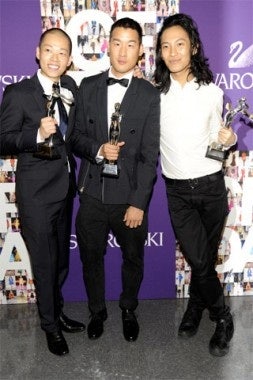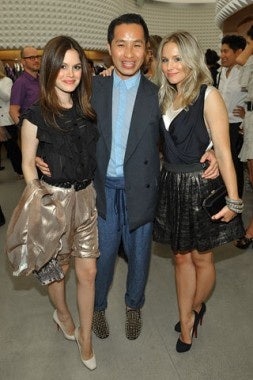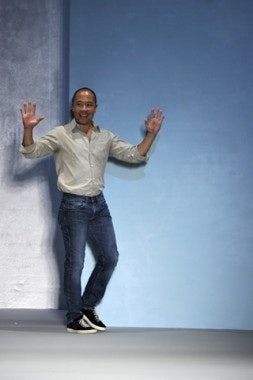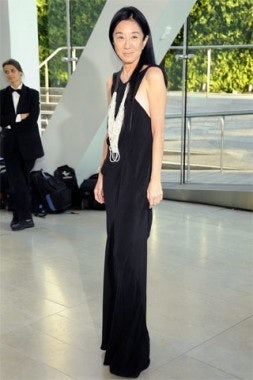Part Two Of Jing Daily’s Fashion Industry Analysis#

At this year's CFDA (Council of Fashion Designers of America) awards, Chinese-American designers Jason Wu and Alexander Wang took home Swarovski Awards for Womenswear and Accessory Design respectively, touching off a wide-ranging discussion on the growing Asian-American influence in the fashion industry. Last week, Jing Daily explored the place of Chinese and Chinese-Americans in China’s emerging fashion market by looking at the growing potential of Chinese models, and now we'd like to turn the spotlight onto designers.
Chinese-American fashion designers are notable among the Asian-Americans rising in the ranks to become critically acclaimed American designers. At this year’s Spring 2011 New York Fashion Week, Asian Americans fared well with the critics, earning high overall ratings on the New York Times Scorecard roundup each day. Focusing on Chinese-American designers in particular, Jing Daily was interested to see if their heritage has helped boost their sales in China. Here, we look at how they are approaching the Chinese market and their reception there.
Vogue China celebrated its fifth anniversary last September by featuring five Asian fashion models on the cover, four of which were Chinese. The magazine also commissioned 30 Chinese designers to produce unique designs reflecting Chinese influences. Several of the 30 were internationally recognized, including Alexander Wang, Phillip Lim, Derek Lam, Jason Wu, and Vera Wang.

Alexander Wang#
is a popular apparel and accessories designer who was born in San Francisco of Taiwanese parents. After dropping out of Parsons, he launched his first full collection in 2007 and won a CFDA award in 2008. Alexander Wang’s collections are Chinese manufactured, helping to reduce the ‘Made in China’ stigma. His label is well recognized among fashionable young Chinese (such as the fashion blogger Sammy), and his products are well represented on the popular online outlet site Taobao. In addition, the models on the cover of Vogue China’s September issue were dressed by Alexander Wang.
Jason Wu#
has gained acclaim quickly over the past two years after Michelle Obama wore a white gown by the designer for the January 2009 Inaugural Ball. The Taiwan-born designer has quickly expanded his womenswear line to include shoes and bags, and is working with cashmere label Tse on limited-edition pieces. Jason Wu is a frequent visitor to Asia, citing it as a natural inspiration, and on recent trips has introduced his line at Lane Crawford in Hong Kong and Beijing. Wu is now well-known in his hometown, having sat down with President Ma Ying-Jeou to discuss the arts in Taiwan, as well as consulting on the design of a new luxury condo, set to open in 2011. Additionally, Jason Wu is returning to Taiwan this week for his brother’s wedding, but also making a quick stop in Beijing to push his eye shadow collection with Shiseido, which targets the Chinese market and will hit stores next month.
Of Chinese heritage,
Phillip Lim#
was born in Thailand. He has stores in New York, Los Angeles, Seoul and Tokyo, while luxury retailers in China, like Lane Crawford and Joyce, stock his Phillip Lim 3.1 collection. In addition, he has collaborated with Lane Crawford on a film series, called 4x3.1, set to launch in the Hong Kong and Beijing Lane Crawford stores in October—another confirmation of Lim’s interest in the Chinese market. The four short films were created by four emerging artists—Victoria Tang in Hong Kong, Rain Li in Beijing, Elle Muliarchyk in New York, and Yi Zhou in Paris—each envisioning a personal story about the Phillip Lim girl. The promotional campaign will feature personal appearances by the artists and by Lim himself, as well as a dedicated website (www.4x31.com) set to launch as part of the roll-out.

Influenced by his Chinese-American parents, who ran a business importing clothing from Asia,
Derek Lam#
attended Parsons School of Design, graduating in 1990. After working for American designer Michael Kors, Lam launched his own line in 2003 and is now also the creative director for ready-to-wear and accessories at Tod’s. A representative of Derek Lam told Jing Daily that awareness of the Derek Lam brand has been rising in China over recent years, with retail stores like Joyce carrying the collections. In addition to being featured in major Chinese fashion magazines, Lam is set to be a guest judge for China’s edition of “Project Runway,” a competition reality show for fashion designers. In a WWD article covering the new uptown Derek Lam store in Manhattan at 724 Madison Avenue, Lam mentioned that expansion to China may precede any additional stores in the U.S. In fact, with Lam’s plans to visit China this month, a retail store in China may come sooner rather than later, as he notes in the article that “the consumer is looking for someone like me, who isn’t as ubiquitous as some of the other brands. I think it’s the right time and the right moment.”
Vera Wang#
is a longtime fashion industry figure, having previously worked at Vogue and Ralph Lauren before launching her own design salon, starting with her renowned wedding gowns. Her Spring-Summer 2011 collection had a range of Asian motifs and textures mixed in, referencing the Lucy Liu character in the movie “Kill Bill.” Born and raised in New York by Chinese parents, over the past several years Vera Wang expanded her brand to include fragrance, jewelry, eyewear, footwear, and a diffusion line called Simply Vera. Company president Mario Grauso has outlined a five-year expansion plan that includes Asia, noting that a diffusion line has the potential to do very well there.

While these prominent designers are making moves to court the Chinese consumer, it is hard to tell quantitatively if their Chinese heritage is beneficial to their various marketing stances. In Derek Lam’s recent visits to Shanghai and Beijing, he noted an increased awareness there of American designers of Asian descent, and “a sense of pride” that “there is a group of Asian-American designers who are coming up in the world.”
It could be that Chinese heritage may not pay off for these designers when vying for the average luxury consumer against global luxury labels like Chanel or Louis Vuitton, but they may have an advantage when competing among smaller labels for the growing fashion-educated segment. In the article on Asian-American influence in the fashion industry, the New York Times also noted the influx of of Asian American and Asian-born students in the last decade, a result of recruiting efforts of countries with rapidly developing fashion industries, as well as the changing attitude in those countries towards fashion careers.
Of the international students enrolled at Parsons, roughly 70 percent now come from Asia, and they reflect a distinctly new attitude towards fashion and the industry. With a growing appreciation of fashion that demands newer trends and designers who inspire, the Chinese consumer is becoming more sophisticated, and these Chinese-American designers—having both established themselves internationally and positioned themselves as future role models and inspirations—may have an advantage over smaller labels as well as domestic Chinese designers.
Article by Felice Jiang